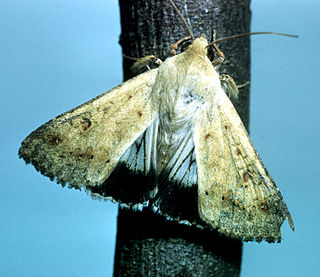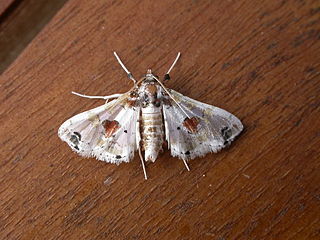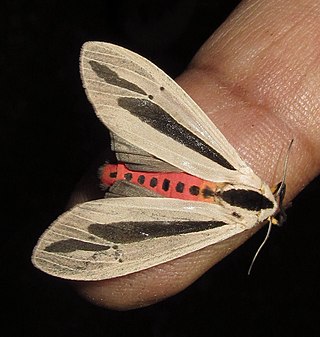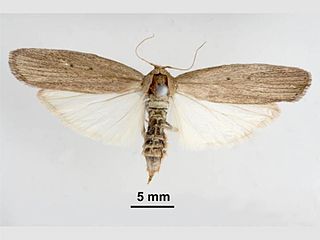
Helicoverpa zea, commonly known as the corn earworm, is a species in the family Noctuidae. The larva of the moth Helicoverpa zea is a major agricultural pest. Since it is polyphagous during the larval stage, the species has been given many different common names, including the cotton bollworm and the tomato fruitworm. It also consumes a wide variety of other crops.

The Pyralidae, commonly called pyralid moths, snout moths or grass moths, are a family of Lepidoptera in the ditrysian superfamily Pyraloidea. In many classifications, the grass moths (Crambidae) are included in the Pyralidae as a subfamily, making the combined group one of the largest families in the Lepidoptera. The latest review by Eugene G. Munroe and Maria Alma Solis retain the Crambidae as a full family of Pyraloidea.

The Indianmeal moth, also spelled Indian meal moth and Indian-meal moth, is a pyraloid moth of the family Pyralidae. Alternative common names are weevil moth, pantry moth, flour moth or grain moth. The almond moth and the raisin moth are commonly confused with the Indian-meal moth due to similar food sources and appearance. The species was named for feeding on Indian meal or cornmeal, and does not occur natively in India. It is also not to be confused with the Mediterranean flour moth, another common pest of stored grains.

The light brown apple moth is a leafroller moth belonging to the lepidopteran family Tortricidae.

The Mediterranean flour moth or mill moth is a moth of the family Pyralidae. It is a common pest of cereal grains, especially flour. This moth is found throughout the world, especially in countries with temperate climates. It prefers warm temperatures for more rapid development, but it can survive a wide range of temperatures.

The European corn borer, also known as the European corn worm or European high-flyer, is a moth of the family Crambidae. It is a pest of grain, particularly maize. The insect is native to Europe, originally infesting varieties of millet, including broom corn. The European corn borer was first reported in North America in 1917 in Massachusetts, but was probably introduced from Europe several years earlier. Since its initial discovery in the Americas, the insect has spread into Canada and westwards across the United States to the Rocky Mountains.

Helicoverpa punctigera, the native budworm, Australian bollworm or Chloridea marmada, is a species of moth in the family Noctuidae. This species is native to Australia. H. punctigera are capable of long-distance migration from their inland Australian habitat towards coastal regions and are an occasional migrant to New Zealand.

Aglossa cuprina, the grease moth, is a snout moth, family Pyralidae, described by Philipp Christoph Zeller in 1872. The grease moth is closely related to the genus Pyralis, and as a result, is usually associated with the meal moth, Pyralis farinalis.

The Angoumois grain moth is a species of the Gelechiidae moth family, commonly referred to as the "rice grain moth". It is most abundant in the temperate or tropical climates of India, China, South Africa, Indonesia, Malaysia, Japan, Egypt and Nigeria, with its location of origin being currently unknown. It is most commonly associated as a pest of field and stored cereal grains as they burrow within the kernel grains of crop plants, rendering them unusable for human consumption. By laying eggs between the grains themselves and hatching at a later time, often during the processing, transportation or storage stages, the moth can be transported to households or countries presently free of Angoumois grain moth infestations. Thus, constant protection against the Angoumois grain moth is required for grain up till the time of consumption.

Amyna axis, the oriental eight-spot, is a moth of the family Noctuidae. The species was first described by Achille Guenée in 1852.

Cadra figulilella, the raisin moth, is a moth of the family Pyralidae. The raisin moth is known most commonly as a pest that feeds on dried fruits, such as the raisin and date. It covers a range that includes much of the world, primarily situating itself in areas of California, Florida, the Eastern Mediterranean region, and some parts of Africa, Australia, and South America. The moth prefers to live in a hot, arid climate with little moisture and plentiful harvest for its larvae to feed on. Study of this species is important due to the vast amount of economic damage it causes yearly and worldwide to agriculture crops.

Leucinodes orbonalis, the eggplant fruit and shoot borer or brinjal fruit and shoot borer, is a moth species in the genus Leucinodes described by Achille Guenée in 1854. Its native distribution is in the tropical and subtropical parts of Australia and Asia, where it is recorded from Pakistan, Nepal, India, including the Andaman Islands, Sri Lanka, Bangladesh, Myanmar, Laos, Cambodia, Vietnam, Thailand, China, Taiwan, Japan, Malaysia, Singapore, Brunei, the Philippines, and Indonesia (Java). It has also been intercepted from fruit imports in the U.S.A., the Netherlands, Denmark and Great Britain, where it was also reported from the wild. A taxonomic revision of the Leucinodes species of Sub-Saharan Africa concluded that L. orbonalis is currently not present in Africa, and that previous records of this species were misidentifications of previously undescribed species.

Creatonotos gangis is a species of arctiine moth in South East Asia and Australia. It was described by Carl Linnaeus in his 1763 Centuria Insectorum.

Eldana is a genus of moths of the family Pyralidae containing only one species, the African sugar-cane borer, which is commonly found in Equatorial Guinea, Ghana, Mozambique, Sierra Leone and South Africa. Adults have pale brown forewings with two small spots in the centre and light brown hindwings, and they have a wingspan of 35mm. This species is particularly relevant to humans because the larvae are a pest of the Saccharum species as well as several grain crops such as sorghum and maize. Other recorded host plants are cassava, rice and Cyperus species. When attacking these crops, E. saccharina bores into the stems of their host plant, causing severe damage to the crop. This behavior is the origin of the E. saccharrina's common name, the African sugar-cane borer. The African sugar-cane borer is a resilient pest, as it can survive crop burnings. Other methods such as intercropping and parasitic wasps have been employed to prevent further damage to crops.

Cadra calidella, the dried fruit or date moth, is a species of snout moth in the genus Cadra and commonly mistaken for the species Cadra figulilella. It thrives in warmer conditions and is found primarily in Mediterranean countries, although it can also be found in Central Asia, Kazakhstan, Transcaucasia, Caucasus, and the western part of Russia. It feeds on dried fruits, carobs, nuts and seeds, hence earning its colloquial name. This diet damages the food industry, and it is a common storage pest. Because of this, much research has been done to study ways to limit its reproduction rate and population size. It was first described by Achille Guenée in 1845.

Polyphagozerra coffeae, the red coffee borer or coffee carpenter, is a moth of the family Cossidae. It was described by John Nietner in 1861 and is found in Asia. Records from the Moluccas and New Guinea refer to Polyphagozerra reticulata, which was previously considered to be a synonym of P. coffeae. It is a widespread pest that attacks many plants.
Fundella pellucens, the Caribbean pod borer, is a species of snout moth in the genus Fundella. It was described by Zeller in 1848.

Parapoynx stagnalis, the rice case bearer or rice caseworm, is a species of moth in the family Crambidae. It has a wide distribution and is found in India, Sri Lanka, South-East Asia, South Africa, South America, southern Europe, Russia and Australia.
Chilo partellus, the spotted stalk borer or spotted stem borer, is a moth in the family Crambidae. It was described by Charles Swinhoe in 1885. It is found in India, Pakistan, Iran, Ethiopia, Lesotho, Madagascar, Malawi, South Africa, Sudan, Tanzania, Uganda and on Mayotte.

Amyna stricta, the eight-spot moth, is a species of owlet moth in the family Noctuidae. It is found in North, Central, and South America.





















